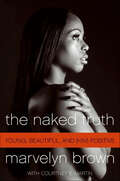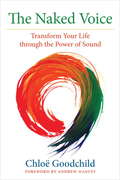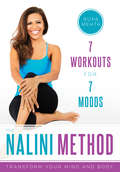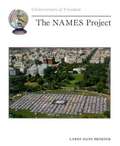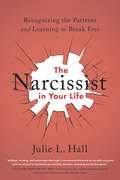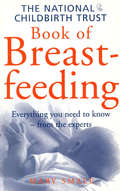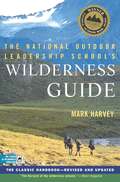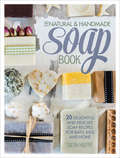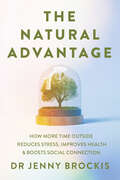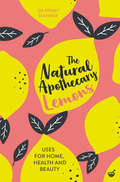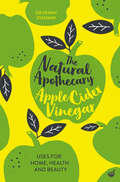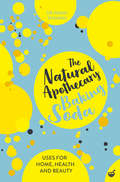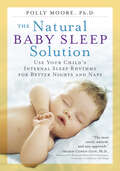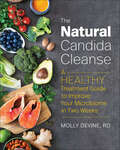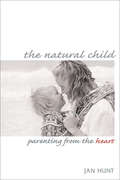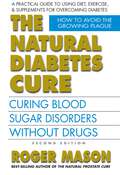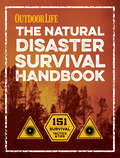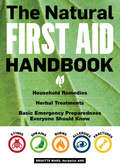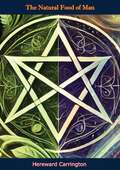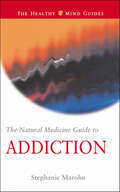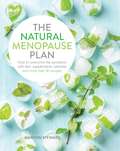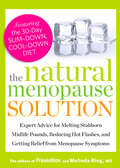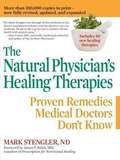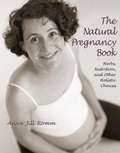- Table View
- List View
The Naked Truth: Young, Beautiful, and (HIV) Positive
by Courtney E. Martin Marvelyn BrownThe surprisingly hopeful story of how a straight, nonpromiscuous, everyday girl contracted HIV and how she manages to stay upbeat, inspired, and more positive about life than ever beforeAt nineteen years of age, Marvelyn Brown was lying in a stark white hospital bed at Tennessee Christian Medical Center, feeling hopeless. A former top track and basketball athlete, she was in the best shape of her life, but she was battling a sudden illness in the intensive care unit. Doctors had no idea what was going on. It never occurred to Brown that she might be HIV positive.Having unprotected sex with her Prince Charming had set into swift motion a set of circumstances that not only landed her in the fight of her life, but also alienated her from her community. Rather than give up, however, Brown found a reason to fight and a reason to live. The Naked Truth is an inspirational memoir that shares how an everyday teen refused to give up on herself, even as others would forsake her. More, it's a cautionary tale that every parent, guidance counselor, and young adult should read.
The Naked Voice
by Chloe GoodchildBoth science and spirituality agree that every particle of matter, every phenomenon we experience, is a form of resonance or vibration. The human voice is quite literally a mouthpiece of this truth; there is no form of expression more personal, more tied to our identities, than our voices. With simple inspirational exercises, this book by renowned voice teacher Chloe Goodchild gives readers the tools to guide them in a process of sound healing and soul communication that is guaranteed to open the heart and restore forgiveness, compassion, and interconnectedness between individuals and in their communities. At the heart of every human journey exists the longing to feel at home in one's self and in the world. In a unique response to meet this longing, Chloe Goodchild invites you on a compelling adventure of self-discovery and creative fulfillment through a direct experience of your own authentic voice--the voice of your personal authority, the song of your soul. Going beyond traditional vocal training guides, this book will appeal to anyone wishing to encounter themselves at a primal level through the medium of the voice.
The Nalini Method: 7 Workouts for 7 Moods
by Rupa MehtaRupa Mehta, called a "pint-sized guru" by Vogue and the "Rachael Ray of Fitness" by the New York Post, has helped thousands of people on their journey to physical and emotional wellness from her New York fitness studio. Now, with The Nalini Method, Rupa brings her revolutionary techniques for shedding emotional weight and achieving balance of body and mind to the wider world with a gorgeous and fun full-color book.The Nalini Method is an innovative mood-based fitness plan that fuses yoga, Pilates, strengthening exercises, and barre work to help participants lose emotional weight and find emotional fitness-transforming both mind and body in the process. Rupa's dynamic techniques synthesize Western and Eastern approaches to create an accessible program that's as challenging as it is fun. The workouts of The Nalini Method help participants find balance within seven different moods:AngerEnergyStressChillHappinessDoubtAnxietyIn addition, Rupa includes recipes for six unique and delicious "mood foods" to help maintain energy and balance along the way.With tips and resources to help any woman achieve her fitness goals every day, The Nalini Method blazes a new and exciting trail to physical and emotional well-being.
The Names Project (Cornerstones of Freedom)
by Larry Dane BrimnerDescribes the continually growing quilt that is being created as a memorial to those who have died of AIDS and to draw attention to this devastating disease.
The Narcissist in Your Life: Recognizing the Patterns and Learning to Break Free
by Julie L. HallA highly illuminating examination of narcissistic personality disorder (NPD) and its insidiously traumatic impact on family members and partners. Packed with insight, compassion, and practical strategies for recovery, this is a must-read for survivors and clinicians alike. Narcissistic personality disorder (NPD) has a profoundly dehumanizing effect on those subject to its distortions, manipulations, and rage. The Narcissist in Your Life illuminates the emotionally annihilating experience of narcissistic abuse in families and relationships, acknowledges the complex emotional and physical trauma that results, and assists survivors with compassionate, practical advice on the path of recovery. Whether you are just learning about NPD, managing a narcissistic parent or other family member, leaving a narcissistic relationship, or struggling with complex PTSD, you will find life-changing answers to these common questions: What are the different forms of NPD?Is my partner a narcissist?Why do I keep attracting narcissistic personalities?How can I help my kids?What happens in a narcissistic family? Why did my other parent go along with the abuse?Why am I alienated from my siblings?Why is it so hard to believe in myself and my future?What is complex PTSD and do I have it?What are the health problems associated with narcissistic abuse? Journalist, survivor, and NPD trauma coach Julie L. Hall provides a comprehensive, up-to-date, affirming, and accessible guide that will not only help you understand narcissistic abuse trauma, but will help you overcome trauma cycles and move forward with healing.
The National Childbirth Trust Book Of Breastfeeding: A Practical And Innovative Guide From Planning Through To Established Gardens
by Mary SmaleThere is no doubt that breast is best and it is the most natural way of feeding your baby. The majority of mothers approach breastfeeding with an optimism and a desire to succeed but in many cases this soon disintegrates into failing milk supplies and sore nipples. No one ever tells you how difficult and painful it can be. is the usual cry from a new mother. Now you can have help permanently on hand in your own home. Fully updated and packed with practical advice on every aspect of breastfeeding - from positioning your baby correctly and latching-on to timing and successful weaning -THEN NATIONAL CHILDBIRTH TRUST BOOK OF BREASTFEEDING offers solutions to the kind of day-day problems and emotional concerns that affect breastfeeding women every day. Written by a counsellor with fifteen year experience and published in association with Britain's largest chidbirth charity, this book will give you the confidence to make your baby's first months happy and trouble-free for both of you.
The National Outdoor Leadership School's Wilderness Guide: The Classic Handbook, Revised and Updated
by Mark HarveyThe classic backpacker’s handbook—revised and updated—providing expert guidelines for anyone who loves the outdoors.The Wilderness Guide brings the savvy of the world's most famous and respected outdoor organization to everyone—from the sixteen million backpacking Americans to the more than 265 million people, tenderfeet and trail-hardened hikers, who visit our national parks annually. It covers: -Selecting equipment—including discussions of the advantages and disadvantages of products such as the internal frame pack, lighter-weight boots, and freestanding tents -The latest “leave no trace” camping techniques -Traveling safely and sensibly—including vital information on maps, compasses, and tips on crossing difficult terrain -Backcountry cooking, with tips on building fires and tricks for making gourmet meals -Search-and-rescue techniques, including how to organize a self-sufficient search group and when to call in professional rescue teams Illustrated throughout with instructional drawings and photos and featuring lists of equipment, the Wilderness Guide is a must-have for anyone planning to explore the great outdoors.
The Natural & Handmade Soap Book: 20 Delightful and Delicate Soap Recipes for Bath, Kids and Home
by Sarah Harper&“The natural products you can make from this book are not only kinder to your skin; they are also better for the planet&” (Soap Making Magazine, &“Top 6 Books for Soap Making&”). From nourishing oat soap bars to impressive rosebud soap cakes and fun soaps for kids, this book will inspire you to make beautiful handmade soap without all the chemicals found in commercial products. Sarah shows you how to master the two key techniques of handmade soapmaking—the traditional cold-process method and the fast and fun melt-and-pour method—and then demonstrates how to use these techniques to make fabulous soaps, shampoo bars, homemade washing powder, and even dishwasher soap bombs. Step-by-step photography and the author&’s insightful advice from years of experience teaching soapmaking makes every project achievable, guiding you effortlessly from start to finish. Packed with handy tips and an easy, approachable style, this is a beautiful book filled with practical projects so that anyone, including children, can make a variety of soaps they will be proud to use, display, and give away! &“This book shows that making soap is not just about the science, but can be another kind of art as it allows makers to bring out their creativity in the process.&” —Bangkok Post &“A fabulous book for anyone interested in all things soap.&” —Sustainable(ish)
The Natural Advantage: How more time outside reduces stress, improves health and boosts social connection
by Jenny BrockisMore time in nature not only makes us feel better, it also enhances our quality of life and contributes to a healthier and longer life. It's the natural advantage! Busy lives mean it's harder than ever to find the space to do those things that help you enjoy a greater quality of life. This has led to what is called a 'nature deficit'. We are so hooked up to our work, our technology and the demands placed on us in our daily lives that we no longer have the time or the energy to indulge in those activities that take us away from all our stresses and concerns to relax, restore our sense of wellbeing and connect to what matters the most. This book will appeal to the reader who recognises or remembers that time in nature is helpful but is wondering how to find the time other than by disappearing on a month-long hike into the wilderness. It has been written for the busy professional juggling multiple items on their agenda, who is feeling overwhelmed and super stressed, and wishing they had even five minutes to get outside and engage in those activities they remember provide them with joy and peace. Engaging in nature-based activities is a powerful tool to create happier, healthier lives.
The Natural Apothecary: Natural Healing with Practical Remedies and Traditional Spiritual Wisdom
by Blake Myers NDExplore the power of natural healing and take charge of your health Learn how herbalism and traditional wisdom can help set you on a path to health and healing with The Natural Apothecary. What sets this book apart from other natural remedies books: Overview of natural medicine—Delve into the differences between conventional Western medicine and herbal medicine, the holistic approach of naturopathy, and the underlying pillars of good health (mindset, lifestyle, and diet). Comprehensive approach to 45 chronic ailments—From anemia and anxiety to rosacea and ulcerative colitis, this herbal medicine book provides insight into dozens of illnesses and their typical symptoms, possible root causes, and potential tests needed. Natural treatment options—This guide offers an array of natural healing remedies, including herbs and supplements, dietary recommendations, lifestyle changes, and easily prepared tinctures. Uplifting affirmations—Each entry ends with a thoughtful mantra to boost spirits and encourage a positive frame of mind on your journey to good health. Find relief for chronic illness as you embrace your inner healer with this essential herbal remedies book.
The Natural Apothecary: Tips for Home, Health and Beauty
by Dr. Penny StanwayA pocket guide to harnessing the power of lemons to use as a natural remedy, beauty aid and household resource.From face masks and hand creams to cleaning products and cold–and-flu remedies, the scent and flavour of lemon have long been used by manufacturers of home and beauty products to imbue their products with the zesty freshness which this citrus fruit is associated worldwide, and it’s little wonder why… Packed with vitamin C, an aid to digestion and linked to sparkling eyes and skin, this humble little fruit is packed with goodness that, with a little know-how, can easily be harnessed to allow you to bypass the chemicals and produce your own all-natural products for home, health and beauty.With our increasing awareness of reducing exposure to chemicals and the importance of keeping things natural, as well as the ever-growing realization of the environmental impact of disposable plastic packaging, there has never been a better time to go back to basics, embrace all-natural ingredients and regain control of what we are putting in and on our bodies. The Natural Apothecary: Lemons opens by exploring the benefits of lemons and looks at how to grow your own at home. The following pages are broken into sections on home, health and beauty, containing over 40 simple recipes for all-natural, home-made products that allow you to utilize the vitality of lemons with ease; make a bruise balm infused with lemon zest, a fragrant hand lotion for soft and youthful skin, or a chemical-free cleaning solution guaranteed to leave your home sparkling.
The Natural Apothecary: Tips for Home, Health and Beauty (Nature's Apothecary Ser. #1)
by Dr. Penny StanwayA pocket guide to harnessing the power of apple cider vinegar to use as a home remedy, beauty aid and household resource.Derived from the world’s most popular fruit, apple cider vinegar has long been revered for its health giving benefits. Linked with weight loss, regulating blood sugar and gut health, as well as its many beauty benefits and practical uses around the home, this super ingredient is a must-have in homes the world over.With our increasing awareness of reducing exposure to chemicals and the importance of keeping things natural, as well as the ever-growing realization of the environmental impact of disposable plastic packaging, there has never been a better time to go back to basics, embrace natural ingredients and regain control of what we are putting in and on our bodies. The Natural Apothecary: Apple Cider Vinegar opens by exploring the different types of apple cider vinegar and the importance of using natural, unfiltered varieties ‘with the mother’. The following pages are broken into sections on home, health and beauty, containing over 40 simple recipes for all-natural, home-made products that allow you to utilize the power of apple cider vinegar with ease; make a soothing balm to ease sunburn, an astringent blemish cream for a clear complexion, or make your own wax polish infused with apple cider vinegar to leave your home sparkling.
The Natural Apothecary: Tips for Home, Health and Beauty (Nature's Apothecary Ser. #3)
by Dr. Penny StanwayA pocket guide to harnessing the power of bicarbonate of soda to use as a home remedy, beauty aid and household resource.Not just for cakes, bicarbonate of soda has long been recognised as a hero ingredient for anyone looking to make their own eco-friendly cleaners and beauty products. Made up of tiny crystals, bicarb’s natural structure makes it the perfect gentle abrasive for home cleaning, and its natural antacid properties are ideal for tackling heartburn or creating antibacterial cosmetics at home.With our increasing awareness of reducing exposure to chemicals and the importance of keeping things natural, as well as the ever-growing realization of the environmental impact of disposable plastic packaging, there has never been a better time to go back to basics, embrace natural ingredients and regain control of what we are putting in our homes and on our bodies. The Natural Apothecary: Bicarbonate of Soda opens by exploring what bicarbonate of soda is made up of, and how it can be both naturally occurring and manufactured. The following pages are broken into sections on home, health and beauty, containing over 40 simple recipes for all-natural, home-made products that allow you to utilize the power of bicarbonate of soda with ease; make a soothing drink to ease indigestion, an all-natural exfoliating scrub to smooth your skin, or a simple but effective stain remover to leave your clothes looking like new.
The Natural Baby Sleep Solution: Use Your Child's Internal Sleep Rhythms for Better Nights and Naps
by Polly MoorePut your baby to sleep! Based on the scientifically established rest and activity cycle that occurs every hour and a half, here’s a proven program to help every parent give their baby better nights and naps. Simply note the time your baby wakes up. Play, feed, or engage with the baby for 90 minutes; then begin to soothe him back to sleep. That’s right, 90 minutes after baby wakes up in the morning, it’s time for a nap; and 90 minutes after the nap, it’s time for another one. In a reassuring style, Dr. Moore explains how and why the program works for babies from two weeks to a year; and how to solve common problems including sleep issues due to illness or traveling across time zones.
The Natural Candida Cleanse: A Healthy Treatment Guide to Improve Your Microbiome in Two Weeks
by Molly DevineRelieve symptoms, improve well-being—a holistic dietary approach to treating candida.You can reset your body's balance with the right food. The Natural Candida Cleanse is an all-natural treatment for candida overgrowth through dietary intervention. If you've been diagnosed with candidiasis, these user-friendly dietary tips and savory recipes can provide you with much-needed relief from your symptoms.Complete with information on what candida overgrowth is, what the symptoms are, the role of probiotics, and much more, this book embodies a holistic approach that will help you achieve a healthy microbiome and feel your best. The Natural Candida Cleanse is exactly what the dietician ordered.This book includes:Focus on facts—Skip the pseudoscience and learn what causes candida overgrowth—and more importantly, what treats it.Professional advice—Get tips from a registered dietician on everything from food journaling to adapting the candida cleanse to a vegan or vegetarian diet.40+ enticing recipes—With delicious foods like Southwestern Stuffed Peppers, Crispy Coconut Salmon, and Chocolate-Almond Chia Pudding, you won't be missing out.Eat your way to symptom relief—The Natural Candida Cleanse makes it easy and tasty.
The Natural Child: Parenting from the Heart
by Jan HuntDiscover an age-old parenting method that treats children with dignity, respect, understanding, and compassion from infancy into adulthood.The Natural Child makes a compelling case for a return to attachment parenting, a child-rearing approach that has come naturally for parents throughout most of human history. In this insightful guide, parenting specialist Jan Hunt links together attachment parenting principles with child advocacy and homeschooling philosophies, offering a consistent approach to raising a loving, trusting, and confident child.The Natural Child dispels the myths of “tough love,” building baby’s self-reliance by ignoring its cries, and the necessity of spanking to enforce discipline. Instead, the book explains the value of extended breast-feeding, family co-sleeping, and minimal child-parent separation.Homeschooling, like attachment parenting, nurtures feelings of self-worth, confidence, and trust. The author draws on respected leaders of the homeschool movement such as John Taylor Gatto and John Holt, guiding the reader through homeschool approaches that support attachment parenting principles.Being an ally to children is spontaneous for caring adults, but intervening on behalf of a child can be awkward and surrounded by social taboo. The Natural Child shows how to stand up for a child’s rights effectively and sensitively in many difficult situations. The role of caring adults, points out Hunt, is not to give children “lessons in life”—but to employ a variation of The Golden Rule, and treat children as we would like to have been treated in childhood.Praise for The Natural Child“I had grown jaded with the flood of parenting books, but The Natural Child is a rare and splendid exception . . . . I can’t praise it sufficiently, and would place it along with Leidloff’s Continuum Concept and my own Magical Child . . . . It could make an enormous difference if read widely enough.” —Joseph Chilton Pierce, author of The Magical Child“In prose that is at the same time eloquent and simple, [Hunt] provides a mix of useful parenting tips that are supported by the philosophy that children reflect the treatment they receive. This is no less than an impassioned plea for the future—not only our children’s future, but the future of our way oof life on this planet.” —Wendy Priesnitz, Editor, Natural Life Magazine
The Natural Diabetes Cure: Curing Blood Sugar Disorders Without Drugs
by Roger MasonNearly twenty million people in North America have diabetes, and each year the number continues to grow. What's most distressing is that diabetes can be easily prevented by simply maintaining a healthy balanced diet. Unfortunately, many people don't realize the serious consequences of that routine trip to their favorite fast food restaurant. Fortunately, however, best-selling author and health advocate Roger Mason is here to help with his updated edition of The Natural Diabetes Cure. In it, he provides a simple, yet effective nutritional approach to preventing and combating diabetes.Divided into two parts, The Natural Diabetes Cure begins by explaining how diabetes develops, its major causes, and the severe health risks associated with this metabolic disorder. Part Two details how a balanced diet of whole grains, fresh fruits, vegetables, and healthy fats not only helps improve health and well-being, but also prevents conditions like high blood pressure, obesity, and insulin resistance, which can lead to type-2 diabetes. Additional chapters discuss the key vitamins and supplements that can help those with diabetes regulate their blood sugar levels. Also included is a practical chapter on how to test insulin levels at home.Living with diabetes does not have to be a life sentence. You have the power to free yourself from this disorder. The Natural Diabetes Cure-with the very latest information on natural, safe, and effective treatments-will show you how.
The Natural Disaster Survival Handbook: 151 Survival Tactics & Tips (Outdoor Life)
by The Editors of Outdoor LifeHow to survive everything from hurricanes and wildfires to earthquakes and tsunamis, from the editors of Outdoor Life. From basic precautions like knowing how to use a fire extinguisher to emergencies like riding out an avalanche, this comprehensive collection of practical advice prepares you to protect yourself, your home, and your family in a wide variety of situations. Included are sections on: The Essential: Get ready with the right emergency kit and first aid supplies. Be ready for earthquakes, floods, blizzards, and other natural disasters wherever you may be. Learn simple tips and techniques for treating common injuries, assessing danger, and getting to safety fast. The Extreme: When a tornado is bearing down on your car, the floodwaters have cut off your home, or you&’re camping and the lightning strikes seem to be getting closer—what do you do? This book tells you, in simple steps with handy illustrations. The Emergency: Mudslides, avalanche, falling boulders often start without warning, leaving little time to prepare—or even think. Be prepared for the worst so you can react quickly. From the premier publication that was founded nearly 125 years ago, this is a valuable resource for those who want to be ready for anything nature throws at them.
The Natural First Aid Handbook: Household Remedies, Herbal Treatments, and Basic Emergency Preparedness Everyone Should Know
by Brigitte MarsCayenne pepper can stop bleeding. Garlic helps alleviate a toothache. Honey soothes a burn. When an emergency situation arises, simple home remedies can play a vital role in easing symptoms and providing immediate help. Become an effective first responder with a combination of best first-aid practices, herbs, and standard homeopathic applications. This quick-reference handbook spells out hundreds of life-saving techniques, commonsense tips, and time-tested herbal remedies that everyone should know. From how to perform basic CPR and the Heimlich Maneuver to the best immediate response to natural disasters, you’ll find the most practical, effective actions to take to ensure survival.
The Natural Food of Man: Being An Attempt To Prove From Comparative Anatomy, Physiology, Chemistry And Hygiene, That The Original, Best And Natural Diet Of Man Is Fruit And Nuts
by Hereward Carrington"The Natural Food of Man" by Hereward Carrington is an insightful and pioneering work that explores the principles of a natural and healthful diet, advocating for a return to the foods that best align with human physiology and promote optimal well-being. Carrington, a noted author and researcher in the field of natural health, provides a thorough analysis of dietary practices, drawing on historical, scientific, and anatomical evidence to support his arguments.In this compelling book, Carrington examines the diet of early humans and compares it with modern eating habits, identifying the fundamental flaws and health consequences of contemporary diets. He argues that the natural food of humans consists primarily of fresh fruits, vegetables, nuts, and grains, which provide the necessary nutrients for sustaining health and vitality. Carrington delves into the benefits of these foods, discussing their impact on digestion, energy levels, and overall physical health.Carrington also critiques the consumption of meat, processed foods, and artificial substances, highlighting their detrimental effects on the body. He provides practical advice on how to transition to a more natural diet, offering meal plans, recipes, and tips for incorporating wholesome, unprocessed foods into daily life."The Natural Food of Man" is not only a guide to healthier eating but also a philosophical exploration of the relationship between diet, health, and nature. Carrington's thoughtful and well-researched arguments encourage readers to rethink their dietary choices and consider the long-term benefits of aligning their eating habits with natural principles.This book is a valuable resource for anyone interested in nutrition, health, and natural living. It appeals to both newcomers to the concept of natural foods and those already familiar with the benefits of a plant-based diet. Hereward Carrington's "The Natural Food of Man" offers timeless wisdom that continues to inspire and inform readers seeking to improve their health through natural and holistic dietary practices.
The Natural Medicine Guide to Addiction
by Stephanie MarohnMedical journalist Stephanie Marohn eases the pain and trauma of addiction recovery in this guide, one in a series dealing with ailments such as anxiety and depression. In layman's terms she discusses how chemical imbalances in the brain create addiction and withdrawal symptoms, and how they can be restored. Suggestions include: amino acid supplements (to regulate sugar levels), herbs such as chamomile, valerian root (to relax the nervous system), acupuncture, aromatherapy, candle therapy, and so on. Marohn's view of addiction is clear enough to see the big picture, which encompasses everything from crippling drug addiction to minor, apparently harmless habits such as compulsive shopping. According to Marohn, addiction is a problem that effects over 100 million people every year, and needn't be seen as either freakish or a sign of "weakness." Furthermore, there is a way to recover that does not compromise a holistic lifestyle through pharmaceutical medicines, should one choose this path.
The Natural Menopause Plan: Over the Symptoms with Diet, Supplements, Exercise and More Than 90 Recipes
by Maryon StewartThe effects of menopause can be utterly debilitating for women, ravaging their physical, mental, and emotional health and often their careers and relationships too. But conventional therapies come with side effects that sometimes seem nearly as bad.Bestselling author Maryon Stewart shows how you can alleviate the symptoms of menopause – naturally and effectively; through diet, supplements, herbal remedies, exercise, and relaxation.The Natural Menopause Plan includes more than 90 delicious recipes. All are easy to make and brimming with vital nutrients, such as calcium, magnesium, and essential fatty acids. Many are especially designed to include naturally occurring estrogens (phytoestrogens); a safe and effective alternative to HRT. You'll find delicious smoothies, pancakes, and muesli recipes for breakfast. Lunch and dinner choices include fresh salads, soups, risotto, bakes, curries, stir-fries, and more, with plenty of options for special diets. Desserts and snacks offer choices like cheesecake, fruit salads, cakes, bars and breads. Each is specially designed to alleviate menopausal symptoms in a healthful, lasting way.Complete with authoritative nutritional information, this is the ultimate guide to combating the effects of the menopause the natural way.
The Natural Menopause Solution: Expert Advice for Melting Stubborn Midlife Pounds, Reducing Hot Flashes, and Get ting Relief from Menopause Symptoms
by Prevention Magazine Editors Melinda RingFor far too long, doctors thought hormone replacement therapy was the answer to menopausal symptoms from hot flashes to sleepless nights to stubborn belly fat. But while it does help, HRT can be risky—and may raise women's chances for breast cancer, heart attack, and stroke. Luckily, there's a growing stack of research that natural remedies can be just as effective.In The Natural Menopause Solution, the editors of Prevention and integrative medicine specialist Melinda Ring, MD, distill that research into the easy-to-follow 30-Day Slim-Down, Cool-Down Diet, which can help women lose 21 percent more body weight. Plus it's proven to help reduce the number and intensity of hot flashes by 50 percent. In addition to this easy eating and exercise program, there are hundreds of drug-free solutions for sleep problems, memory lapses, mood swings, lack of energy, low libido, and more—and strategies to protect against heart disease, diabetes, stroke, osteoporosis, and cancer.
The Natural Physician's Healing Therapies: Proven Remedies Medical Doctors Don't Know
by Mark StenglerAn updated and revised edition-from "a leader in the new wave of true healers". From fast-acting natural cures for arthritis, viruses, and hardened arteries, to fatigue, burns and injuries and more, this revised edition of one of the most trusted books on natural remedies includes more than 50 new entries as well as updates throughout.
The Natural Pregnancy Book
by Ina May Gaskin Aviva Jill RommReading The Natural Pregnancy Book is like having your own personal herbalist and midwife at your side. Expertly written by Aviva Jill Romm, who has been providing family-centered natural health care for almost twenty years, it guides women through treating the common ills and ailments of pregnancy simply with herbs and nutrition. Aviva thoughtfully follows the woman's journey from baby's conception to birth, describing herbs that can promote and maintain a healthy pregnancy, along with those you should avoid during your term. Her herbal remedies cover such familiar concerns as anxiety, fatigue, morning sickness, and stretch marks. She also discusses the components of a healthy diet, with an emphasis on natural foods. With its detailed information and comforting voice, The Natural Pregnancy Book is a complete primer for the woman who envisions a safe pregnancy as nature intended it. Book jacket.
